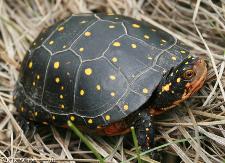Thursday, May 15, 2025
Bucket Traps & Drift Fences
Written by Hannah Jacobowitz, MNA Communications Intern
This spring, MNA is trying something new at some of our sanctuaries – and with promising results! With the help of long-time MNA volunteer Dan Burton, we’ve been experimenting with a relatively new method in wildlife sampling research, known as AHDriFT – or the adapted hunt drift fence technique.
Normally, a drift fence sampling technique would involve setting up drift fences (essentially long, tarp-like barriers), which would impede an animal’s path and guide them in a specific direction. Then, they would fall into a bucket trap, which is made up of a large bucket sunk into the ground along the fence. These traps would then be checked periodically in order to assess the types of wildlife frequenting the area.
However, more recently the technique has seen some amendments – with the new method, buckets are placed upside down above-ground, with holes cut out on either side. Then, each bucket is outfitted with a motion-sensitive trail camera to photograph each creature that passes through. This method not only provides less of an impediment to the natural routines of the wildlife that encounter these traps, but also lessens the frequency with which researchers and stewards need to visit and check the traps in person.
AHDriFT Passive Sampling Technique Set - Up
“It's kind of a low time investment,” says Andrew Myers, MNA’s conservation scientist overseeing the project. “But it could really pay off in terms of finding out that we have some cool species in some of our sanctuaries that we didn't know about already.”
Right now, we are on the lookout for three endangered species in particular – the eastern massasauga rattlesnake, the smooth green snake, and the spotted turtle. While we don’t know as of yet whether we’ll encounter these species, finding them would be a hopeful indication that the habitats in these sanctuaries are being successfully restored, as well as further encouragement to cater our stewardship to creating the specific environments in which these species can thrive.

Left to Right. Spotted Turtle (Clemmys guttata) and Eastern Maassassauga Rattlesnake (Sistrurus catenatus catenatus)
Additionally, since many of these species are more timid in nature, this new, hands-off approach serves as a promising alternative to sampling techniques that require more of an in-person presence.
“A lot of the snakes, turtles, and [herptiles] are really secretive, so even when you’re looking for them, you usually can’t find them,” says Ayden Ehgotz, MNA’s conservation coordinator for the Eastern Lower Peninsula. “So this kind of passive approach over the course of a summer hopefully will allow us to get some insight into the reptile community, which then can drive some of our management decisions.”
Critters captured by trail camera




